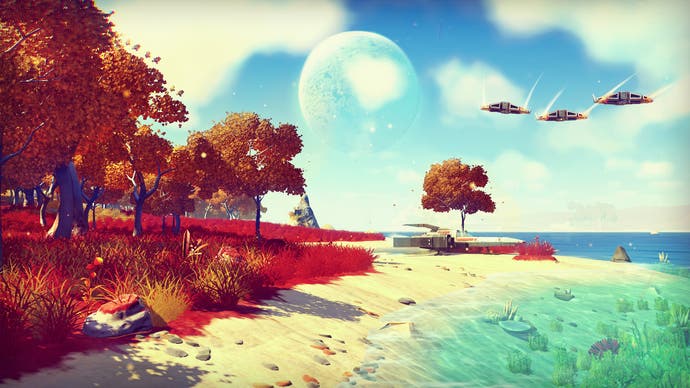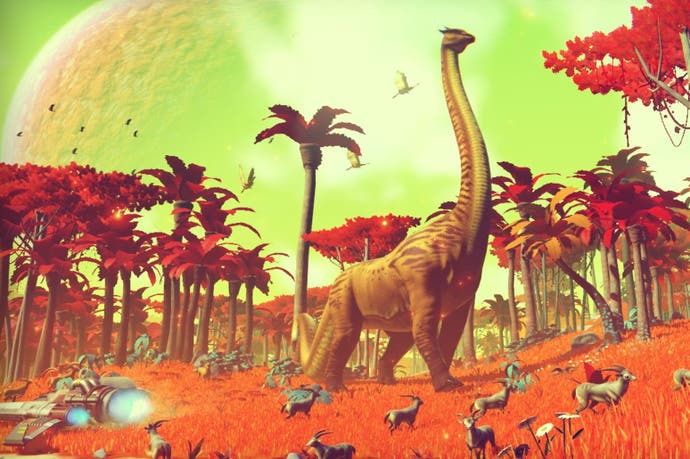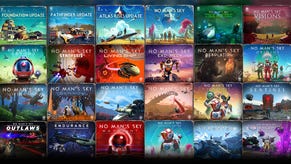How No Man's Sky stole the show at E3
And why it's the first game designed for the YouTube generation.
There's a time and a place for subtlety, and the stage of a platform holder's conference very likely isn't it. Having just played a starring role in Sony's E3 show, Hello Games' Sean Murray watched the rest unfold in bemusement in the green room, puzzled as to why every grotesque fatality in the newly revealed Mortal Kombat 10 was met with a cheer. "What is that about?" he asks no-one in particular. "It all seems a bit brutal for us Europeans."
Murray's own game, the ambitious and enigmatic No Man's Sky, was met with a different kind of reaction. "It's a nightmare to have a game like this and do something like E3," he says a couple of days after the show in a rented downtown LA apartment. "The normal gameplay of Call of Duty is built for three minutes of shock and awe that actually when you play is exactly the same every time. It's like watching a video, and it plays itself. Our game is the absolute opposite."
What met the gameplay demonstration of No Man's Sky - a condensed look at a supposedly infinite world that took in space dinosaurs, extra-terrestrial fauna and fleets of starships in one seamless, breathless swoop - was a different response to the usual bloodlust roar of a conference crowd. It was a sense of shock and awe, but this time expressing itself in a stunned moment of silence. How could a game with this scope, and with this ambition, be coming from a team of four in Guildford?
"No!" Murray interjects. "Let's get that straight! There were four of us working on it originally, and there's like seven now. There's 10 in Hello Games in total."
Apologies for the slip-up, Sean - it turns out the team behind No Man's Sky is positively huge. "Yeah, but people go like 'it's still the four of you!' It's unfair to the others. It's become this thing with Hello Games, that it's just four guys."
Whether it's four, seven or 10 is irrelevant, though. No Man's Sky is so staggering in scope, you'd find it hard to believe a team of 200 could deliver on the vision. "At EA, where I used to work, not that anyone would greenlight it but if you would pitch the game one of the biggest things people would say is with our 200 people team we couldn't do this," says Murray. "It's too grandiose, too ambitious. We've just had to approach it from the angle of us wanting to make the game we wanted to make."
The silent staff member that's helping them towards their vision is bespoke technology that assists in quickly creating diverse new planets with which to populate No Man's Sky's vast universe. "It's our version of Unity," says Murray as he runs us through the tools at Hello Games' disposal, with the assistance of colleague Grant Duncan. "It's really powerful, but it looks s***.
"If you imagine that we have like a create-a-character thing that you can move the sliders and change the skin colour. If you imagine we have that for everything - the tech makes it possible to do that.
"So Grant actually still built something like this," Murray says as he shows us a single tree within No Man's Sky's toolbox. "It's untextured when he built it, and it's just kind of a prototype - if you view variants, it'll create variations on that. It'll change leaf types and textures, and you can click on one of those and do variations on that. It's not just things like trees, which I do think look cool, but if you go to a ship you can view variants on that. We're creating one ship, and then we're creating from that endless ships - tens of thousands of variants of that. But we won't create one ship, we're create lots of ships, and each of those will have variations."
Different rule-sets will help underline different variations - creatures will naturally populate the world, but there will be male and female types of the same breed who will interact with each other accordingly, while ships with bigger engines will naturally offer a larger amount of thrust.
"There are rules, and wherever we have a situation where we're like 'this is how science works, and this is how gameplay works', gameplay always wins," says Murray. "So, for instance, we say that you have a suit, and that means that gravity is kind of nullified. It's super weird to have a game where, every planet you land on, you walk at a different speed, you run at a different speed and you jump at a different speed."

The dark art that underpins No Man's Sky's universe might be a little clearer, but that doesn't strip away any of the wonder as you stand on one of its planets and look to the heavens. Up in the sky, you can see the floating islands and speckled flocks of dinosaurs on the planets that hang in the atmosphere's thick haze. It's a sense of wonder Murray is understandably protective of. Keeping the enigma intact is imperative to a game all about the thrill of discovery, though some elements are defined.
"We do start everyone on a different place on the outside edge of the galaxy," says Murray, reiterating his grand statement from Sony's conference. "It is the same for everyone, but they are actually not just hundreds of miles apart, they could be billions of miles apart. So the chances of you bumping into someone are really, really small - but we do want you to have that sense of playing with other people."
So what actually happens should you ever cross paths with another player? "We haven't really talked about multiplayer, but I want kind of a Journey-esque feel to it," says Murray. "You get a sense that you're playing with other people, and you can see the actions of other people, plus you'll share things that are significant - if you take out a space station, we'll share that, and that'll be shared across the entire universe - but if you shoot down a bird, that won't be. In terms of interactions, it's really infrequent. But when it happens we want people to get a feel that we're playing with other people. We're doing that in loads of different ways - for instance, when you fly to the centre of the galaxy, when you get there is something you can do, and that causes an event and that is seen by everyone.
"The main thing that everyone is sharing, and the main sense that you're playing with other people, is that this galaxy, when you bring it up for the first time, it's completely blank. You can see all the planets, but the map will just say a number. And when you explore, you see the caves, or fly down to a planet for the first time, I can choose to upload that and share with everyone. That's the same with creatures, or different types of ship, or where a space station is or whether something's toxic, what resources are there and whether there's a crashed ship."
As more is discovered, more of the map is filled in, though you're only ever going to place your mark on a fraction of it. "The size and scale of the universe we're making is so vast, you're only ever going to touch a tiny piece of that. The thing with something being infinite is no matter how much of it you explore, divided by infinity it still approaches zero."

So much of the wonder that surrounds No Man's Sky has obscured a little of what the minute-to-minute play is going to be like. The fuzziness exists in part because a lot of that lies in the player's hands - there will be no tutorial, and no initial objectives with the only thread at the start the simple desire to explore - though it's worth remembering that much of this vast universe will be hostile, and so much of your time will be dedicated to nothing more than survival.
"I hope we've gotten that across!" says Murray. "The idea, with the gameplay that we showed, is that the planets are dangerous. It hurts me that some people think we're making this ambient indie game that you walk around and look at trees and scan them, like some universal Pokemon Snap. What we're making has core action. I hope we got that across. When you're on a planet, there are creatures that are dangerous. You see the drones and they're just a sneak peak of the mechanical, and you can interact with - they can be dangerous and they can be friendly. You are really interacting in this universe."
The wingmen in the gameplay trailer at Sony's conference are allies you can make in your journey - and those other fighters that warp into view can be destroyed or passed by. It's a hostile world, but one that's full of blossoming possibilities. "It's inspired by actual sci-fi stories and books, and we want the player, when they recount something that's happened, for it to feel like one of those books, and for it to feel real. And to be like when people tell stories they have in DayZ, and it sounds like a zombie novel or an episode of the Walking Dead."
Indeed, it's DayZ that's perhaps the best point of comparison for No Man's Sky - not for its minute-to-minute survival, or, hopefully, for any creakiness, but for its ability to house stories that can be shared. Sean Murray and his team may have made the game that's been whistling around their heads since they first started playing with computers, but it's being realised at a time when emergent, open worlds are big business.
"This is a game made for people who make YouTube videos of games, the Let's Play generation," says Murray. "People who want to take screenshots and build a community wiki and track what out's there. We believe that, being completely open, we won't tell you how the game works. We want people to discover that themselves, and still be discovering things after a year of play."









